|
August 30, 2002: Road to Revolution
|
|
August 30, 2002: Road to Revolution
|
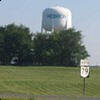
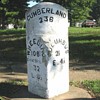
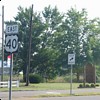 The story of Fort Laurens is just one of the many bits of Ohio history
that I first learned from Allan Eckert. And, like many of the others, it entered
my mental list of "places I might visit some day" as I read his
account. This was Ohio's only Revolutionary War fort and there is a
memorial where it once stood in the northeast part of the state. Over
time, a flimsy plan developed to combine a visit to Fort Laurens with a
trip to the National Road Museum near Zanesville. I woke this morning with
the idea that today might be a good day to follow through.
The story of Fort Laurens is just one of the many bits of Ohio history
that I first learned from Allan Eckert. And, like many of the others, it entered
my mental list of "places I might visit some day" as I read his
account. This was Ohio's only Revolutionary War fort and there is a
memorial where it once stood in the northeast part of the state. Over
time, a flimsy plan developed to combine a visit to Fort Laurens with a
trip to the National Road Museum near Zanesville. I woke this morning with
the idea that today might be a good day to follow through.
The first step was easy. Head north to US 40. This was on I-71 and, even though I missed the heart of Columbus by using the outer belt, I still had to travel east a few miles before the sense of multi-lane expressways and big city congestion started to ease. I can't say if this is the first of the old National Road mile markers east of Columbus but it is the first I spotted. It's in the town of Kirkersville. In Hebron, I left 40 for a short run up Ohio 79 to my first stop. |
|
|
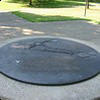
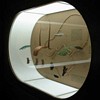
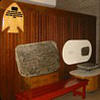
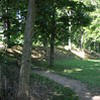 That stop was at the
Great Circle Earthworks at Newark. One of three
locations preserving parts of what was once the largest system of
connected geometric earthworks anywhere. The other locations are the
Octagon Earthworks and the
Wright Earthworks. The Great Circle complex includes
the first museum devoted to prehistoric American Indian art with artifacts
(and some reproductions) from the local mounds as well as some other
locations. The petroglyphs are from Meigs county and are known as the
Saxon Petroglyphs. Not all of the original mounds remain. Like many
others, some were plowed into oblivion by farmers. A portion of the Newark
structures has the dishonor or distinction of having been used as the
Licking county fairgrounds from 1854 through 1898 then becoming an
amusement park that lasted until 1933. During the Civil War a military
training camp was here and Buffalo Bill's Wild West Show made an
appearance in 1884. Even today, the Octagon Earthworks are on the
Moundbuilders Country Club golf course. Fore!
That stop was at the
Great Circle Earthworks at Newark. One of three
locations preserving parts of what was once the largest system of
connected geometric earthworks anywhere. The other locations are the
Octagon Earthworks and the
Wright Earthworks. The Great Circle complex includes
the first museum devoted to prehistoric American Indian art with artifacts
(and some reproductions) from the local mounds as well as some other
locations. The petroglyphs are from Meigs county and are known as the
Saxon Petroglyphs. Not all of the original mounds remain. Like many
others, some were plowed into oblivion by farmers. A portion of the Newark
structures has the dishonor or distinction of having been used as the
Licking county fairgrounds from 1854 through 1898 then becoming an
amusement park that lasted until 1933. During the Civil War a military
training camp was here and Buffalo Bill's Wild West Show made an
appearance in 1884. Even today, the Octagon Earthworks are on the
Moundbuilders Country Club golf course. Fore!
|
|
|
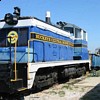
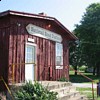 Just west of Jacksontown, I unexpectedly came upon the
Buckeye Central Scenic
Railroad. Everything was closed up tight today but a new looking
sign gave departure times of 1:00 and 3:00 on Saturdays and Sundays and
the web site backs that up.
Just west of Jacksontown, I unexpectedly came upon the
Buckeye Central Scenic
Railroad. Everything was closed up tight today but a new looking
sign gave departure times of 1:00 and 3:00 on Saturdays and Sundays and
the web site backs that up.
|
|
|
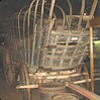
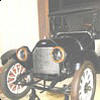 The National Road and Zane Grey Museum lies a few miles
east of Zanesville and does a fine job of describing the history of the
road both with words and a series of miniature reconstructions. The
depictions of various locations and periods of the road are enclosed
behind clear plastic panels on which the well written descriptions are
printed. This presents a rather thorough picture that is easy to grasp
in person but just doesn't make for good photos with standard tourist
equipment. The same is true of the sizable section devoted to Zanesville
native son, Zane Grey, and some impressive examples of Zanesville art
pottery. I did get a picture of a Conestoga wagon that represents the most
common vehicle on the road in its earliest days and a shot of an old
Chevy roadster just to show that Model Ts did at least have some distant
competition.
The National Road and Zane Grey Museum lies a few miles
east of Zanesville and does a fine job of describing the history of the
road both with words and a series of miniature reconstructions. The
depictions of various locations and periods of the road are enclosed
behind clear plastic panels on which the well written descriptions are
printed. This presents a rather thorough picture that is easy to grasp
in person but just doesn't make for good photos with standard tourist
equipment. The same is true of the sizable section devoted to Zanesville
native son, Zane Grey, and some impressive examples of Zanesville art
pottery. I did get a picture of a Conestoga wagon that represents the most
common vehicle on the road in its earliest days and a shot of an old
Chevy roadster just to show that Model Ts did at least have some distant
competition.
|
|
|
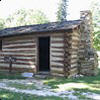
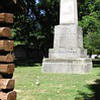
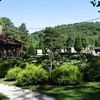 Billing itself as the oldest existing settlement in Ohio,
Gnadenhutten, is
some 40 miles northeast of Zanesville. Originally settled in 1772 by
Mohicans converted to Christianity by Moravian missionaries it is also
the site of the first white birth in the territory. But another event
that took place here was neither the first nor last of its sort in Ohio.
Even in a period of common brutally and frequent atrocities, what
occurred at Gnadenhutten in the spring of 1782, stands out.
Billing itself as the oldest existing settlement in Ohio,
Gnadenhutten, is
some 40 miles northeast of Zanesville. Originally settled in 1772 by
Mohicans converted to Christianity by Moravian missionaries it is also
the site of the first white birth in the territory. But another event
that took place here was neither the first nor last of its sort in Ohio.
Even in a period of common brutally and frequent atrocities, what
occurred at Gnadenhutten in the spring of 1782, stands out.
The Moravians and their converts established a total of five missions in the region and tried to remain neutral while British, rebelling colonists, and various native tribes clashed around them. Paranoia is among those things bred by war and paranoia was rampant throughout the American frontier in the late 1700s. In the fall of 1781, the British forcibly moved the residents of Gnadenhutten to what amounted to an eighteenth century concentration camp on the Upper Sandusky. After a winter of near starvation, some of the captives were given permission to return to their homes in hopes of retrieving something of the crops they had been forced to abandon. Of course, the British had no monopoly on paranoia and, when American militia discovered the scavengers, the Indians were immediately captured. A few natives had been killed, without provocation, as the soldiers closed in but most, plus members of the group found at the nearby Salem settlement, became prisoners. On the morning of March 8, 1782 29 men, 27 women, and 34 children were methodically put to death and the entire village burned. Two young boys escaped. In 1798, missionary John Heckewelder returned to the location and started the current settlement. All human bones that could be found were placed in a single mound that has remained undisturbed since that time. The large monument was erected in 1872. Today, many cabins, including the two "slaughter houses", have been reconstructed on their original locations. The floor of the Cooper Shop has a screened opening to the cellar where one of the survivors hid. At the museum, an informative video can be seen along with various artifacts and an extensive arrow head display. The Gnadenhutten massacre is depicted in the outdoor drama Trumpet in the Land just a few miles away. |
|
|
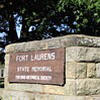
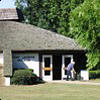
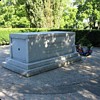
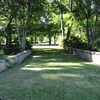 I had intended to next visit another Moravian site, Schoenbrunn, but, as
is usually the case, time had slipped away. I opted to head straight to
Fort
Laurens to avoid a lockout. A good thing, too, since, although I had
plenty of time to tour the
museum, I saw Dick closing things down shortly after I
went outside. The fort was occupied for less than a year. In November of
1778, General Lachlan McIntosh left 176 men and 5 women at the fort with
only meager provisions. Neither supplies or relief were forthcoming and
the garrison's winter was at least as difficult as the previous one had
been for the troops at Valley Forge. Hostile Indians, often led by British
officers, were frequently seen. But crossing the Tuscarawas doesn't
compare with crossing the Delaware and the fort was abandoned in August
1779. There have been several excavations at the site. In 1976, one of 22
bodies in the fort's cemetery was enshrined in the Tomb of the Unknown
Soldier of the American Revolution.
I had intended to next visit another Moravian site, Schoenbrunn, but, as
is usually the case, time had slipped away. I opted to head straight to
Fort
Laurens to avoid a lockout. A good thing, too, since, although I had
plenty of time to tour the
museum, I saw Dick closing things down shortly after I
went outside. The fort was occupied for less than a year. In November of
1778, General Lachlan McIntosh left 176 men and 5 women at the fort with
only meager provisions. Neither supplies or relief were forthcoming and
the garrison's winter was at least as difficult as the previous one had
been for the troops at Valley Forge. Hostile Indians, often led by British
officers, were frequently seen. But crossing the Tuscarawas doesn't
compare with crossing the Delaware and the fort was abandoned in August
1779. There have been several excavations at the site. In 1976, one of 22
bodies in the fort's cemetery was enshrined in the Tomb of the Unknown
Soldier of the American Revolution.
The last picture is of a bridge over the Ohio-Erie Canal. Not far beyond the far end of the bridge is where the southwest corner of Fort Laurens once stood. Interstate 77 passes just behind where I stood to take the picture. When the fort was occupied, the Tuscarawas river flowed by its eastern wall and a pathway connected fort and river bank. Construction of the highway actually moved a section of the river eastward so that the four lane interstate now separates the fort and the river. Just another case of mid twentieth century blind progress destroying history? Not exactly. Long before I-77 was even dreamed of, the location of the path and the gate it lead to had been sliced through to form the canal. Besides, the fort of 1778 wasn't even the first military construction at the site. McIntosh's site selection was partly influenced by the fact that the area was already cleared of trees and this was because they had been cut by Colonel Henry Bouquet's troops in 1764 in order to construct a blockhouse. Occupied for only a month, the blockhouse probably stood about 80 feet southwest of the Fort Laurens stockade. It was in a rather decrepit state by the time Fort Laurens was built. Bouquet had several such blockhouses built and one can still be seen in Pittsburgh. There is also quite a bit of evidence of prehistoric Native American activity in the area. A spot just south of the blockhouse site seems to have been rather popular. So it seems prehistoric people stopped here because it was high and dry and Bouquet probably picked it for many of the same reasons. McIntosh then chose to build a fort here with the fact that it was somewhat clear added to those natural reasons. The canal followed the river through here and the cleared banks may or may not have made a difference. Moving the river to lay down I-77 just left the layers of human history intact. |
|
|
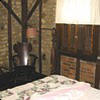
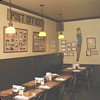
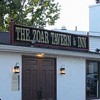 The day ended with a bit of serendipity. I had skipped Schoenbrunn in
order to reach Fort Laurens and I headed back that way. It was nearly 6:00
and I knew that anything closing at the end of the day had already done
so. I headed down a scenic route toward the town of Zoar. I used to live
in an unincorporated town named Zoar and was aware that there was a
"real" Zoar (with a post office) elsewhere in Ohio. I also knew
it had connections with a religious group of some sort. When I drive into
a town full of really neat looking old buildings - a real "historic
district". I know immediately that this is worth a stop and finally
acknowledge that seeing Schoenbrunn and getting home tonight is not
realistic. I'll probably be spending the night in the area. I see the
tavern sign and pull over; not knowing if it is real or a museum tavern.
It's real and I head in for a beer. Not only is it a real tavern, it's a
real restaurant. I haven't eaten all day and the menu looks great. Near
the end of a very good meal, I learn (actually verify) that this is also a
real inn. Amy, my waitress, comes back with news that rooms are available
and I'm soon set for the night. I moved my car out back and myself
upstairs. The room is small but comfortable; looks old but feels modern. I
returned to the tavern for a couple more beverages with peanuts in the
shell. The bartender, Susan, had never heard of Fort Laurens (about 3
miles away) but was a good and friendly tavern tender none the less. So
the Zoar Tavern
& Inn turned out to be real, had good draft beer, served a great
meal, and provided a comfortable place to sleep plus I've learned enough
about Zoar to make me really look forward to seeing it tomorrow.
The day ended with a bit of serendipity. I had skipped Schoenbrunn in
order to reach Fort Laurens and I headed back that way. It was nearly 6:00
and I knew that anything closing at the end of the day had already done
so. I headed down a scenic route toward the town of Zoar. I used to live
in an unincorporated town named Zoar and was aware that there was a
"real" Zoar (with a post office) elsewhere in Ohio. I also knew
it had connections with a religious group of some sort. When I drive into
a town full of really neat looking old buildings - a real "historic
district". I know immediately that this is worth a stop and finally
acknowledge that seeing Schoenbrunn and getting home tonight is not
realistic. I'll probably be spending the night in the area. I see the
tavern sign and pull over; not knowing if it is real or a museum tavern.
It's real and I head in for a beer. Not only is it a real tavern, it's a
real restaurant. I haven't eaten all day and the menu looks great. Near
the end of a very good meal, I learn (actually verify) that this is also a
real inn. Amy, my waitress, comes back with news that rooms are available
and I'm soon set for the night. I moved my car out back and myself
upstairs. The room is small but comfortable; looks old but feels modern. I
returned to the tavern for a couple more beverages with peanuts in the
shell. The bartender, Susan, had never heard of Fort Laurens (about 3
miles away) but was a good and friendly tavern tender none the less. So
the Zoar Tavern
& Inn turned out to be real, had good draft beer, served a great
meal, and provided a comfortable place to sleep plus I've learned enough
about Zoar to make me really look forward to seeing it tomorrow.
|
|
|
|
|